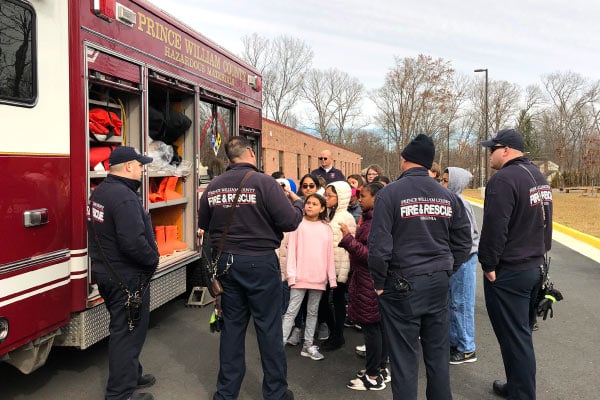 This
story
features
a
learning
activity
that
took
place
prior
to
school
closures
due
to
COVID-19.
This
story
features
a
learning
activity
that
took
place
prior
to
school
closures
due
to
COVID-19.What if a tanker truck was involved in an accident on the Route 123 bridge and its contents began spilling into the Occoquan River? Antietam Elementary School Gifted Education Teacher Kathy Lamont posed this hypothetical question to her fifth-grade students in a problem-based learning lesson. The local setting made the problem more realistic, but a presentation from the Prince William County Department of Fire and Rescue's (PWC DFR) Hazardous Materials (HazMat) Operations Team gave students an inside look at what really happens when a scenario like this occurs.
Divided into groups, students needed to figure out what the spill was (hydrochloric acid) and what actions were needed to protect both people and the environment. To protect the people, they needed to re-route traffic. Using maps, they were able to direct traffic to Interstate 95, which helped drivers avoid the incident. But the bigger problem was working with an environmental group that was concerned about the toxic liquid spilling into the Occoquan River.
Fifth-grader Joy Svendsen said, "I liked doing experiments because we got to use the pH strips and do real things." Her classmate Aryanna Beach shared, "My favorite part was when we tested everything with the pH strips."
During their presentation, PWC DFR Captain Chris Adams and HazMat Coordinator Matt Adkins talked to students about the hypothetical incident in the lesson and related it to real events that have taken place. They also shared the Emergency Response Guidebook, a resource they carry with them that is published by the U.S. Department of Transportation, Pipeline and Hazardous Materials Safety Administration.
"It was cool to see they use the book that has each acid and the solutions for what to do with that acid or base," fifth-grader Amina Kanu shared. During the presentation, Brianna Atkinson picked up on a key point about hazmat incidents, "Sometimes you can't do everything; sometimes you just have to stand back and watch, which is hard."
Much to their delight, one of the presenters donned the chemical suit that first responders may wear at hazmat scenes. Fifth-grader Sarah Loy explained, "It takes a long time to put on the hazmat suit." Her classmate, Joy, added, "It was really cool that they put it on for us."
"I love being able to partner with people who actually do the things we study. It shows the students that what we are learning is important. And, if they like something they learn, there's probably someone doing a job and using that information." Lamont shared.
